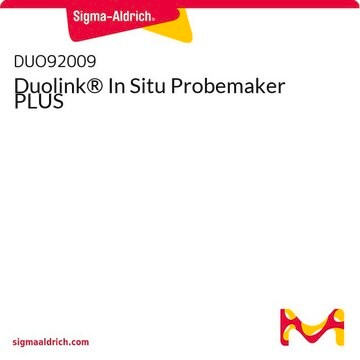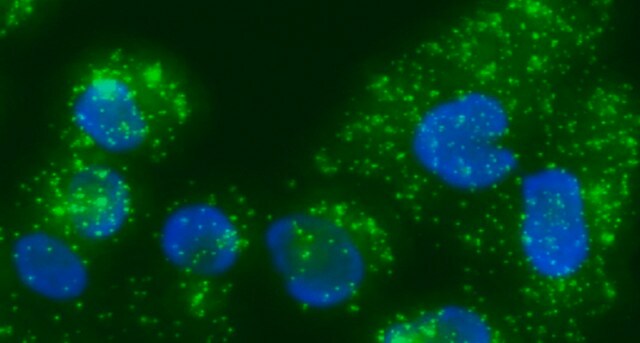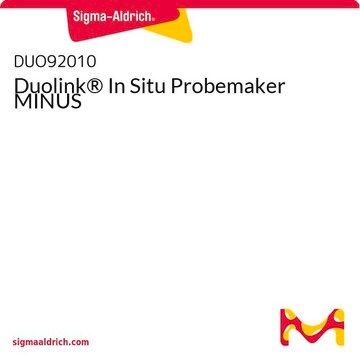The Duolink PLA Probes offered are donkey polyclonal antibodies directed to the whole molecule (heavy and light chains). They are affinity purified. The same polyclonal antibody is conjugated to the Plus and Minus Oligos. The Plus and Minus probes can be used together (to detect a single antibody) since they can recognize multiple sites. The anti-mouse IgG PLA labeled antibodies may cross-react with rat but this is not consistent. Do not use this product with rat antibodies. It is best to label anti-rat secondary antibodies with the Duolink Probemaker kit.The anti-goat IgG PLA labeled antibodies have cross-reactivity with sheep IgG and can be recommended for this application.
DUO92006
Duolink® In Situ PLA® Probe Anti-Goat MINUS
Affinity purified Donkey anti-Goat IgG (H+L)
Sinónimos:
in situ Proximity Ligation Assay Kit, Protein Protein Interaction Kit
Seleccione un Tamaño
Seleccione un Tamaño
About This Item
Productos recomendados
biological source
donkey (polyclonal)
Quality Level
antibody form
affinity purified immunoglobulin (secondary antibody)
antibody product type
primary antibodies
product line
Duolink®
species reactivity
goat
technique(s)
immunofluorescence: suitable
proximity ligation assay: suitable
suitability
suitable for brightfield
suitable for fluorescence
shipped in
wet ice
storage temp.
2-8°C
Categorías relacionadas
Application
This product can be applied to both the Duolink® In Situ Fluorescence Protocol and the Duolink® In Situ Brightfield Protocol depending on the detection reagents used.
Visit our Duolink® PLA Resource Center for information on how to run a Duolink® experiment, applications, troubleshooting, and more.
To perform a complete Duolink® PLA in situ experiment you will need two primary antibodies (PLA, IHC, ICC or IF validated) that recognize two target epitopes. Other necessary reagents include a pair of PLA probes from different species (one PLUS and one MINUS), detection reagents, wash buffers, and mounting medium. Note that the primary antibodies must come from the same species as the Duolink® PLA probes. Analysis is carried out using standard immunofluorescence assay equipment.HRP is also available for brightfield detection.
PLA probe anti-Goat reacts with whole molecule goat IgG and the light chains of other goat immunoglobulin?s. The PLA probe anti-Goat may cross-react with sheep antibodies, but has minimal cross reactivity with chicken, guinea pig, Syrian hamster, horse, human, mouse,rabbit, and rat serum proteins. A PLUS probe of a different species must be used simultaneously with this product. See our Product Selection Guide for more information.
Application Note
Two primary antibodies raised in different species are needed. Test your primary antibodies (IgG-class, mono- or polyclonal) in a standard immunofluorescence (IF), immunohistochemistry (IHC) or immunocytochemistry (ICC) assay to determine the optimal fixation, blocking, and titer conditions. Duolink®PLA in situ reagents are suitable for use on fixed cells, cytospin cells, cells grown on slide, formalin-fixed, paraffin embedded (FFPE), or tissue (fresh or frozen). No minimum number of cells is required.
Let us do the work for you, learn more about our Custom Service Program to accelerate your Duolink® projects
View full Duolink® product list
Features and Benefits
- No overexpression or genetic manipulation required
- High specificity (fewer false positives)
- Single molecule sensitivity due to rolling circle amplification
- Relative quantification possible
- No special equipment needed
- Quicker and simpler than FRET
- Increased accuracy compared to co-IP
- Publication-ready results
Components
- 5x PLA Probe Anti-Goat MINUS - Donkey anti-goat secondary antibody conjugated to oligonucleotide MINUS
- 1x Blocking Solution - Reagent for blocking of the sample
- 1x Antibody Diluent - For dilution of PLA probes and primary antibodies
Legal Information
¿No encuentra el producto adecuado?
Pruebe nuestro Herramienta de selección de productos.
Storage Class
10 - Combustible liquids
Elija entre una de las versiones más recientes:
Certificados de análisis (COA)
¿No ve la versión correcta?
Si necesita una versión concreta, puede buscar un certificado específico por el número de lote.
¿Ya tiene este producto?
Encuentre la documentación para los productos que ha comprado recientemente en la Biblioteca de documentos.
Los clientes también vieron
Artículos
Things to consider for preparation, setup and execution of the Duolink® assay protocol
Support information including tips and tricks, frequently asked questions, and basic troubleshooting.
Protocolos
Duolink® PLA reagents enable brightfield detection and quantification of proteins and interactions in tissue samples.
Contenido relacionado
Applications to detect, quantify and visualize protein-protein interactions, post-translational modifications and low expression protein detection using proximity ligation assay
-
What epitope on the antibody is recognized by the Duolink PLA Probes?
1 answer-
Helpful?
-
-
Has Duolink been used for detection of changes in protein expression?
1 answer-
The following reference cites the use of Duolink to detect changes in protein expression in Human. Raizer et al., Cancer 2010;116:5297-305
Helpful?
-
-
What is the Department of Transportation shipping information for this product?
1 answer-
Transportation information can be found in Section 14 of the product's (M)SDS.To access the shipping information for this material, use the link on the product detail page for the product.
Helpful?
-
-
How many reactions can be performed with the Duolink® In Situ Starter Kit?
1 answer-
All of the starter kits for the Duolink product line will perform 30 reactions using 40 ul per reaction. DUO92101 - Duolink® In Situ Red Starter Kit Mouse/Rabbit DUO92102 - Duolink® In Situ Orange Starter Kit Mouse/Rabbit DUO92103 - Duolink® In Situ Red Starter Kit Mouse/Goat DUO92104 - Duolink® In Situ Orange Starter Kit Mouse/Goat DUO92105 - Duolink® In Situ Red Starter Kit Goat/Rabbit DUO92106 - Duolink® In Situ Orange Starter Kit Goat/Rabbit
Helpful?
-
Active Filters
Nuestro equipo de científicos tiene experiencia en todas las áreas de investigación: Ciencias de la vida, Ciencia de los materiales, Síntesis química, Cromatografía, Analítica y muchas otras.
Póngase en contacto con el Servicio técnico









